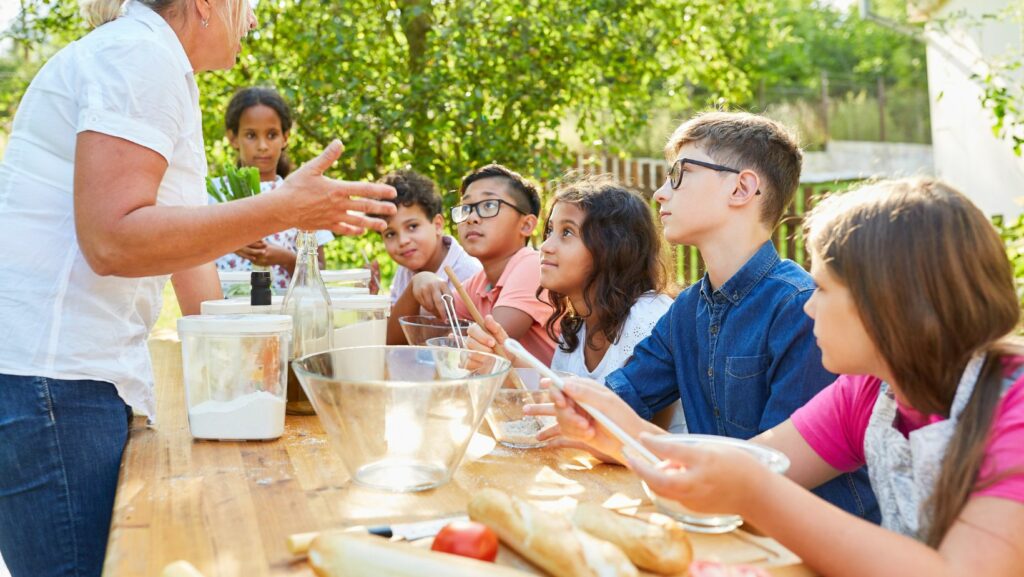Imagine a kitchen filled with laughter, tiny hands covered in flour, and the smell of freshly baked cookies. Welcome to the world of cooking with kids! It’s an adventure that’s not only fun but also packed with learning opportunities. From math skills to science experiments, the kitchen is a classroom waiting to be explored.
Kid Cooking With Mom
Children taking part in the culinary process fosters a multitude of benefits. Not only does it provide practical skills, it cultivates academical abilities, instills self-reliance and nurtures an appreciation for fresh, wholesome food.
Benefits of Involving Kids in the Kitchen
 Engaging Kid Cooking With Mom in the kitchen harvests ample benefits. Firstly, it’s an excellent platform for academic advancement. As children measure ingredients, they enhance math skills. Following recipes supports literacy, comprehension, and sequencing abilities, while observing food change from raw to cooked sharpens scientific insights.
Engaging Kid Cooking With Mom in the kitchen harvests ample benefits. Firstly, it’s an excellent platform for academic advancement. As children measure ingredients, they enhance math skills. Following recipes supports literacy, comprehension, and sequencing abilities, while observing food change from raw to cooked sharpens scientific insights.
Secondly, it stimulates self-sufficiency. Children learn to prepare simple dishes – a good start towards a fundamental life skill. They discover the art of meal planning, grasping the concept that appetizing meals don’t just magically appear on the table.
Lastly, it can foster healthier eating habits. Kids often show a greater inclination to consume food they’ve helped prepare, even if it’s packed with vegetables. They gain a better understanding of where food comes from, leading to an appreciation for fresh over processed fare.
Building Basic Cooking Skills
Kitchen lessons offer a chance to acquire basic cooking skills. Young hands learn to wash and chop vegetables, crack eggs, mix dough and stir solutions. They learn about using kitchen tools properly, cooking techniques and of course, the paramount importance of kitchen hygiene and safety. For example, teaching them that cutting boards need proper sanitization after being used for raw meat, or that dishwasher temperatures need to reach 160°F (71°C) to effectively kill germs.
Kids started on this culinary path early in life often grow into adults with confident cooking skills, a penchant for wholesome foods, and a positive attitude towards meals – invaluable rewards for their investment of time and effort in the kitchen.
Planning a Kid-Friendly Cooking Session
After understanding the numerous benefits of engaging kids in the kitchen, the next step entails planning a delightful, educational, and safe cooking session. This part delves into the consideration points when selecting recipes and preparing your kitchen to be a safe cooking haven.
Choosing the Right Recipes
 Recipe selection holds paramount importance when planning a kid-friendly cooking session. Chosen recipes must be suited for children, focusing on simplicity and engaging tasks. For instance, taco salad or fruit kebabs would make excellent choices. Both provide numerous tasks that kids can participate in such as assembling, stirring, chopping with safety knives, as well as learning valuable concepts of taste and texture combination.
Recipe selection holds paramount importance when planning a kid-friendly cooking session. Chosen recipes must be suited for children, focusing on simplicity and engaging tasks. For instance, taco salad or fruit kebabs would make excellent choices. Both provide numerous tasks that kids can participate in such as assembling, stirring, chopping with safety knives, as well as learning valuable concepts of taste and texture combination.
Moreover, consider the child’s dietary needs and preferences. Incorporating their favorite foods elevates their interest and thereby the learning curve. An example could entail making an apple pie if the child savors apples.
Honestly, an ideal cooking timeline involved in a child’s-friendly recipe does not exceed 30 minutes. This consideration ensures the child remains engrossed without overwhelming them or causing undue strain.
Keep the sessions interactive and fun, it’s okay to make a bit of a mess, remember it’s about creating memories and bonding with the child. The ultimate goal is to ensure they develop a positive association with cooking and healthy eating.
Safety First: Preparing Your Kitchen
Safety preparations for kids in the kitchen are unquestionably crucial to keep the little ones away from harm’s way. Firstly, keep all sharp objects, electrical appliances, and chemicals out of reach. Never forget that hot surfaces and substances pose a significant risk; ensure handles are always turned toward the cooktop’s center and hot liquids are stored at unreachable heights.
Secondly, acquaint children with hygiene rules, including handwashing, clean countertops, and properly stored food. For example, teaching proper knife usage with a child-safe knife minimizing risk.

